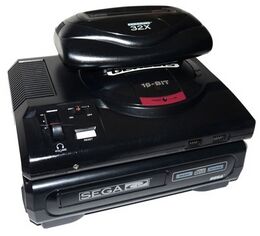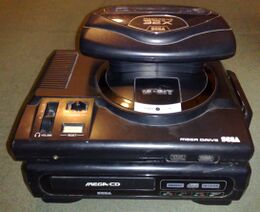Difference between revisions of "Sega Mega-CD 32X"
From Sega Retro
m |
m (→Legacy) |
||
| Line 22: | Line 22: | ||
Owing to a number of reasons, the system eventually developed a curious reputation among the Western gaming community under the colloquial term '''Tower of Power'''. Deriving its name from the increased height added by the extra systems, it generally consists of a Model 1 [[Mega Drive]] and [[Mega-CD]] with an attached [[32X]]. While originally intended to provide a synergy between the three platforms, supporting the 16-bit hardware's entry into the 32-bit era, the visible failure of the 32X combined with the quirks of assembling the combined hardware eventually resulted in the Mega-CD 32X attaining a cult status among the larger gaming community. | Owing to a number of reasons, the system eventually developed a curious reputation among the Western gaming community under the colloquial term '''Tower of Power'''. Deriving its name from the increased height added by the extra systems, it generally consists of a Model 1 [[Mega Drive]] and [[Mega-CD]] with an attached [[32X]]. While originally intended to provide a synergy between the three platforms, supporting the 16-bit hardware's entry into the 32-bit era, the visible failure of the 32X combined with the quirks of assembling the combined hardware eventually resulted in the Mega-CD 32X attaining a cult status among the larger gaming community. | ||
| − | While the term is sometimes used to deride the system for its seemingly-ridiculous expansions, it is more frequently used as an ironic symbol of [[Sega]]'s clout during the 1990s. The combined abilities of the three systems (regardless of their lacking Western libraries) are often framed to represent a level of "power" unable to be achieved by other platforms. This representation is not limited to the larger gaming community, as Sega themselves have made reference to the name. | + | While the term is sometimes used to deride the system for its seemingly-ridiculous expansions, it is more frequently used as an ironic symbol of [[Sega]]'s clout during the 1990s. The combined abilities of the three systems (regardless of their lacking Western libraries) are often framed to represent a level of "power" unable to be achieved by other platforms. This representation is not limited to the larger gaming community, as Sega themselves have made reference to the name, most famously in the miniature recreation of the system, the [[Mega Drive Tower Mini]]. |
==Artwork== | ==Artwork== | ||
Latest revision as of 05:43, 16 November 2023

The Sega Mega Drive console received two add-on hardware upgrades during its life time: the Sega Mega-CD and Sega 32X. It is possible to install both of these on the same base console, creating a system called the Super 32X CD (Japan and Korea) or Sega Mega-CD 32X (PAL region) or Sega CD 32X (USA). This opens the possibility of software that can utilise both the Mega-CD's enhanced storage capacity and ability to play Red Book CD audio, and the 32X's enhancements in graphics and sound capabilities.
Six games were released that require both add-on units in order to be played. All of these titles are full motion video based games, which were previously available as standalone Mega-CD games, and later had their FMV assets upgraded to take advantage of the 32X's improved graphics. As such, all six were released on CDs, with the cart slot of the 32X being unused during gameplay.
Japan did not receive any Mega-CD 32X games, however North America received five while Europe recieved four of those five. Surgical Strike, once bound for a North American release, ended up being an exclusive title in Brazil (and curiously wound up being the only Mega-CD 32X game to reach this region). A further half-dozen titles were in development for the Mega-CD 32X at one stage, but were all cancelled, some merely appearing in Mega-CD form and some being moved to the Sega Saturn.
Games
- Corpse Killer
- Fahrenheit
- Night Trap
- Slam City with Scottie Pippen
- Supreme Warrior
- Surgical Strike (Brazil only)
History
Legacy
Owing to a number of reasons, the system eventually developed a curious reputation among the Western gaming community under the colloquial term Tower of Power. Deriving its name from the increased height added by the extra systems, it generally consists of a Model 1 Mega Drive and Mega-CD with an attached 32X. While originally intended to provide a synergy between the three platforms, supporting the 16-bit hardware's entry into the 32-bit era, the visible failure of the 32X combined with the quirks of assembling the combined hardware eventually resulted in the Mega-CD 32X attaining a cult status among the larger gaming community.
While the term is sometimes used to deride the system for its seemingly-ridiculous expansions, it is more frequently used as an ironic symbol of Sega's clout during the 1990s. The combined abilities of the three systems (regardless of their lacking Western libraries) are often framed to represent a level of "power" unable to be achieved by other platforms. This representation is not limited to the larger gaming community, as Sega themselves have made reference to the name, most famously in the miniature recreation of the system, the Mega Drive Tower Mini.
Artwork
Localised names
| Language | Localised Name | English Translation |
|---|---|---|
| English (UK) | Mega CD 32X | Mega CD 32X |
| English (US) | Sega CD 32X | Sega CD 32X |
| Japanese | スーパー32XCD | Super 32X CD |
| Portuguese (Brazil) | Mega 32X CD | Mega 32X CD |
| Korean | 슈퍼 32X CD | Super 32X CD |
External links


